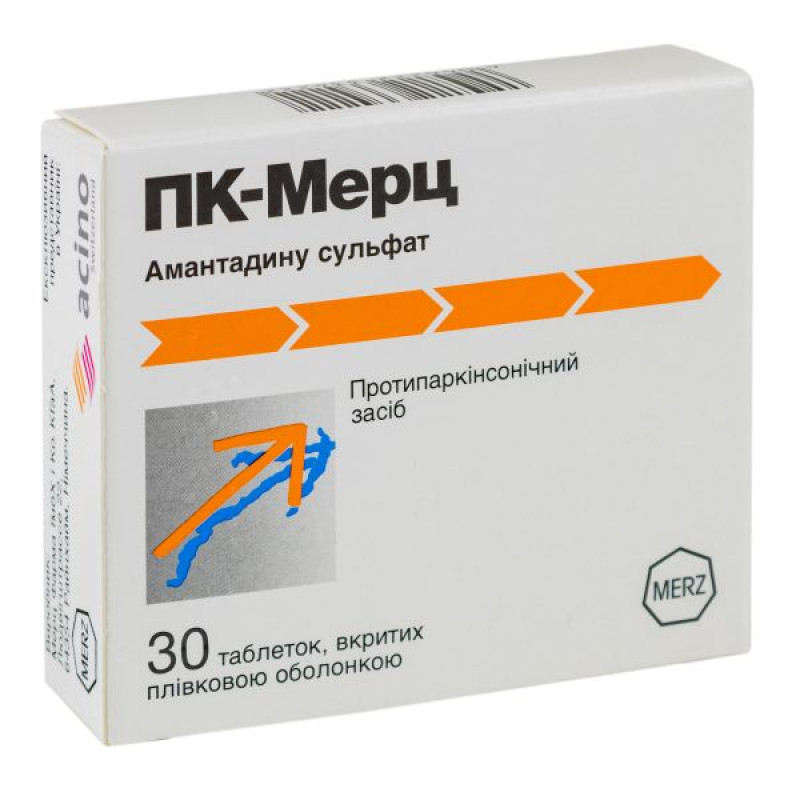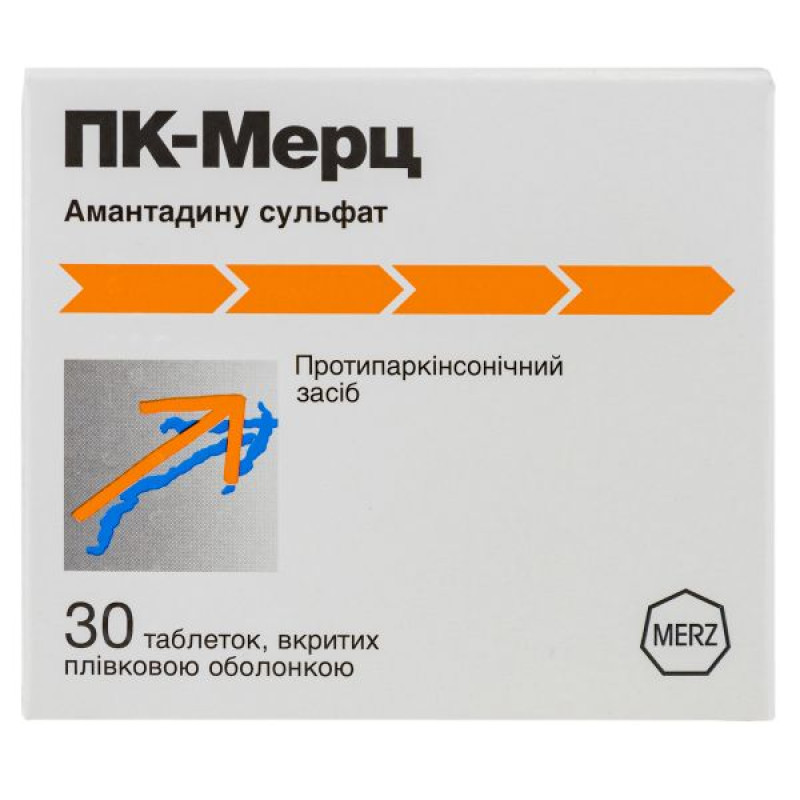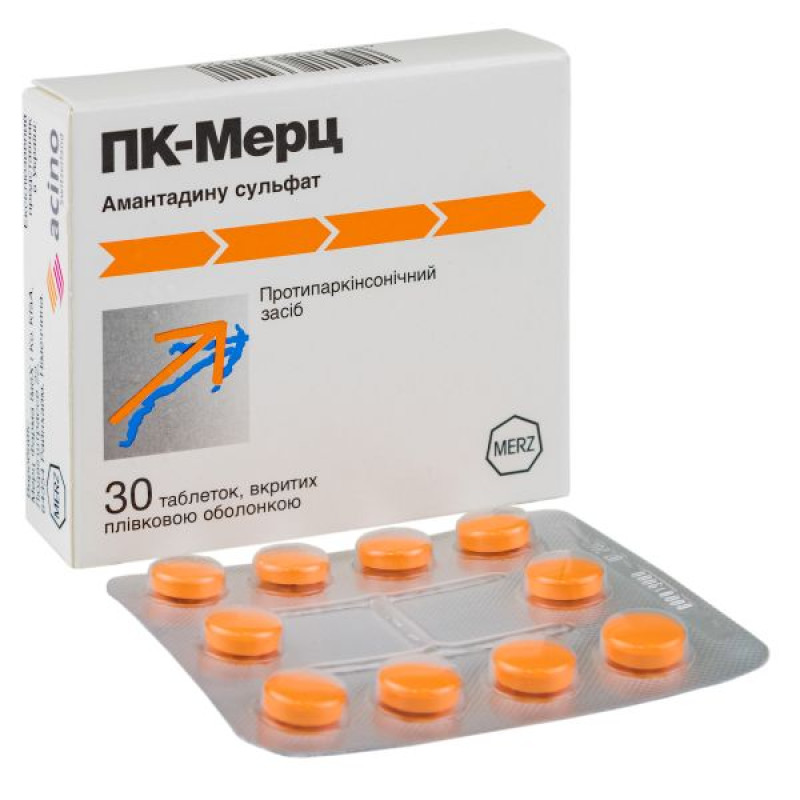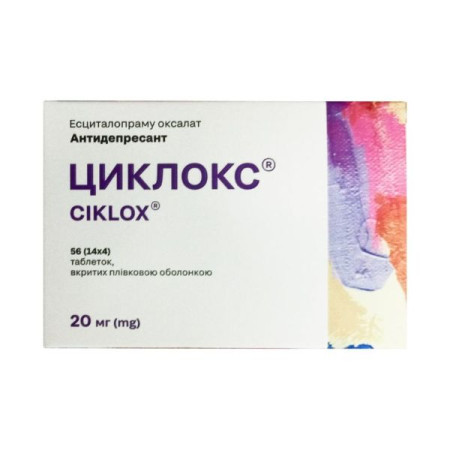Pk-Merz film-coated tablets 100 mg No. 30

Instructions for use of Pk-Merz film-coated tablets 100 mg No. 30
Composition
active ingredient: 1 tablet contains amantadine sulfate 100 mg;
excipients:
tablet core: lactose monohydrate, microcrystalline cellulose, potato starch, gelatin, povidone, croscarmellose sodium, talc, colloidal anhydrous silica, magnesium stearate;
tablet shell: talc, butyl methacrylate-(2-dimethyl-aminoethyl)-methacrylate-methyl methacrylate copolymer (1:2:1), titanium dioxide (E 171), magnesium stearate, orange yellow S (E 110).
Dosage form
Film-coated tablets.
Main physicochemical properties: orange, round, biconvex, film-coated tablets with a score on one side, odorless.
Pharmacotherapeutic group
Antiparkinsonian drugs. Dopaminergic drugs. Adamantane derivatives. Amantadine.
ATX code N04B B01.
Pharmacological properties
Pharmacodynamics.
Amantadine has various pharmacological properties. It exhibits indirect striatal dopamine receptor agonist properties. Animal studies have shown that amantadine increases extracellular dopamine concentrations both by increasing dopamine release and by blocking reuptake in presynaptic nerve cells. At therapeutic concentrations, amantadine inhibits NMDA receptor-mediated acetylcholine release and may thus exert anticholinergic effects. Amantadine has a synergistic effect with L-dopa.
Pharmacokinetics.
Amantadine is rapidly and completely absorbed from the gastrointestinal tract after oral administration. Peak plasma concentrations are reached 2–8 hours (tmax) after a single dose.
The readily soluble amantadine hydrochloride gives higher plasma concentrations than the less soluble amantadine sulfate, which has a later peak plasma concentration (Cmax) than the hydrochloride. A Cmax of 0.5 μg/ml is achieved after a single oral dose of 250 mg amantadine hydrochloride.
When taking the drug at a dose of 200 mg/day, the equilibrium concentration is reached after 4–7 days with a plasma concentration of 400–900 ng/ml. After taking 100 mg of amantadine sulfate, Cmax is 0.15 μg/ml.
The total amount of active substance absorbed (AUC) is the same for the two amantadine salts.
Plasma clearance is determined to be identical to renal clearance and is 17.7 ± 10 l/h in healthy adult volunteers. The apparent volume of distribution (4.2 ± 1.9 l/kg) is age-dependent and is 6 l/kg in adults.
The elimination half-life is 10–30 hours, with a mean of 15 hours, and is largely dependent on the patient's age. In elderly men (62–72 years), the half-life is 30 hours. In patients with renal insufficiency, the terminal plasma half-life may be significantly prolonged (up to 68 ± 10 hours).
Amantadine is approximately 67% bound to plasma proteins (in vitro); approximately 33% is found in plasma in an unbound form. It crosses the blood-brain barrier via saturable transport systems.
It is excreted in the urine almost unchanged (90% of a single dose), a small amount is excreted in the feces.
The dialyzability of amantadine is low – almost 5% per dialysis.
Amantadine is not metabolized in the human body.
Indication
Parkinson's syndrome: treatment of symptoms of Parkinson's disease, such as rigidity, tremor, hypokinesia and akinesia.
Extrapyramidal side effects of neuroleptics and other drugs: tardive dyskinesia, akathisia, and parkinsonism.
Contraindication
The medicine should not be used by patients:
with hypersensitivity to amantadine, orange-yellow S (E 110) or any other components of the drug;
with decompensated heart failure (stage IV according to the classification developed by the New York Heart Association – NYHA);
with cardiomyopathy and myocarditis;
with atrioventricular block II and III degree;
with bradycardia (less than 55 beats/min);
with prolonged QT interval (QTc > 420 ms according to Bazett's formula) or with prominent U-waves, or with a family history of congenital QT syndrome;
with severe ventricular arrhythmia, including chaotic polymorphic ventricular tachycardia;
who are simultaneously treated with budipine or other drugs that prolong the QT interval (see section "Interaction with other medicinal products and other types of interactions");
with low levels of potassium or magnesium in the blood.
with epilepsy and other convulsive seizures;
with severe renal failure;
with peptic ulcer disease.
Special safety precautions
Patients who are taking neuroleptics and PK-Merz simultaneously are at risk of developing neuroleptic malignant syndrome if PK-Merz is suddenly discontinued.
Intoxication may occur in patients with kidney damage.
Particular caution should be exercised when prescribing the drug to patients with organic brain syndrome or patients prone to seizures, as seizures and exacerbation of existing symptoms may occur (see sections “Method of administration and dosage” and “Adverse reactions”).
Patients with Parkinson's disease often experience symptoms such as hypotension, hypersalivation, hyperhidrosis, fever, heat retention, edema, and depression. When treating such patients, special attention should be paid to adverse reactions and interactions of PK-Merz with other drugs.
An ophthalmologist should be consulted if symptoms of visual acuity loss or blurred vision occur to rule out corneal edema. If corneal edema is diagnosed, PC-Merz should be discontinued. Corneal edema caused by PC-Merz usually resolves within a month of discontinuation of treatment.
Patients should inform their doctor if they experience difficulty urinating.
Interaction with other medicinal products and other types of interactions
Concomitant use of amantadine with other drugs that cause QT prolongation is contraindicated. These include:
certain class IA (e.g. quinidine, disopyramide, procainamide) and class III (e.g. amiodarone, sotalol) antiarrhythmics;
certain neuroleptics (e.g. thioridazine, chlorpromazine, haloperidol, pimozide);
certain tricyclic and tetracyclic antidepressants (e.g. amitriptyline);
certain antihistamines (e.g. astemizole, terfenadine);
certain macrolide antibiotics (e.g. erythromycin, clarithromycin);
certain gyrase inhibitors (e.g. sparfloxacin);
azole antifungals and other drugs such as budipine, halofantrine, cotrimoxazole, pentamidine, cisapride, and bepridil.
This list is not exhaustive. Before starting to take other medicines together with PK-Merz, you should carefully read the instructions for use regarding the possible interaction of these medicines with amantadine, which may lead to prolongation of the QT interval.
The drug can be used with other antiparkinsonian drugs. To avoid side effects (such as psychotic reactions), the dose of other drugs or their combinations should be reduced.
Specific studies of the interaction of PK-Merz with other antiparkinsonian agents (e.g. levodopa, bromocriptine, trihexylphenidyl) or memantine have not been conducted (see section "Adverse reactions").
The use of PK-Merz simultaneously with other drugs may cause the following interactions.
Anticholinergics: Increased side effects (confusion and hallucinations) of anticholinergics (such as trihexylphenidyl, benztropine, scopolamine, biperiden, orphenadrine, etc.).
Sympathomimetics with direct action on the central nervous system (CNS). Enhancement of the main action of amantadine.
Alcohol. Decreased alcohol tolerance.
Levodopa (antiparkinsonian drug). Mutual enhancement of therapeutic effects. Therefore, levodopa can be prescribed simultaneously with PK-Merz.
Memantine (a drug for dementia). Memantine may enhance the effect and side effects of the drug PK-Merz (it is important to pay attention to the section "Special instructions for use"), so simultaneous use with memantine should be avoided.
Diuretics: Concomitant use of diuretics such as triamterene/hydrochlorothiazide may reduce the plasma clearance of amantadine, leading to toxic plasma concentrations of amantadine. Therefore, concomitant use of this combination should be avoided.
Application features
Special care should be taken when administering the drug to patients:
with psychoses;
with impaired liver function;
with thyrotoxicosis;
with recurrent eczema;
with prostatic hypertrophy;
with narrow-angle glaucoma;
with renal failure (risk of amantadine accumulation due to impaired renal filtration, see sections "Method of administration" and "Special precautions for use");
with agitation or confusion;
with a history of delirium syndrome or exogenous psychosis;
who are taking memantine at the same time (see section "Interaction with other medicinal products and other types of interactions").
who are simultaneously using drugs that affect the CNS (see section "Interaction with other medicinal products and other types of interactions").
An ECG (50 mm/s) and a manually determined Bazett-corrected QT interval (QTc) should be performed before initiation of treatment and after 1 and 3 weeks of treatment. An ECG should be performed before any subsequent dose increase and 2 weeks after. Thereafter, an ECG should be performed at least annually. Treatment should not be initiated or discontinued if the baseline QTc value exceeds 420 ms, if the QT increases by more than 60 ms during treatment with the drug, or if the QTc value exceeds 480 ms, or if U waves are detected on the ECG.
If symptoms such as palpitations, dizziness or fainting occur, treatment with PK-Merz should be discontinued immediately and the patient should be monitored for 24 hours for QT prolongation. If there is no QT prolongation, treatment with the drug can be resumed, taking into account contraindications and interactions.
In patients with pacemakers, accurate determination of the QT interval is not possible, therefore the decision to use the drug PK-Merz should be made individually after consultation with a cardiologist.
The additional use of amantadine for the prevention and treatment of influenza A is not recommended due to the risk of overdose.
Amantadine treatment should not be discontinued abruptly as this may lead to exacerbation of Parkinson's disease, the appearance of symptoms characteristic of neuroleptic malignant syndrome, as well as the development of cognitive disorders such as: catatonia, confusion, disorientation, deterioration of mental status, delirium. Amantadine should not be abruptly discontinued in patients who are simultaneously using neuroleptics due to the risk of developing neuroleptic-induced catatonia.
Suicide attempts and suicidal thoughts have been reported in patients receiving amantadine. To prevent the emergence of suicidal thoughts and intentions, the drug should be prescribed in the lowest effective dose.
Some patients may develop peripheral edema with prolonged use of the drug. This should be taken into account in patients with chronic heart failure.
The drug is not used in patients with angle-closure glaucoma.
Orange Yellow S (E 110) may cause allergic reactions.
The drug contains lactose, therefore patients with rare hereditary forms of galactose intolerance, lactase deficiency or glucose-galactose malabsorption syndrome should not take the drug.
Use during pregnancy or breastfeeding
Amantadine is contraindicated in pregnant women and women planning to become pregnant.
The drug is contraindicated during breastfeeding, as it passes into breast milk. If necessary, use of the drug should be discontinued.
Ability to influence reaction speed when driving vehicles or other mechanisms
Given the possible adverse reactions of the drug on the central nervous system, it is recommended to refrain from driving or operating other mechanisms during treatment with the drug.
Method of administration and doses
The tablets should be taken with a small amount of liquid, preferably in the morning and afternoon. The last dose of the day should not be taken after 4:00 PM.
Single and daily doses.
To prevent the life-threatening side effect of chaotic polymorphic ventricular tachycardia, the above precautions and contraindications should be considered.
Treatment of patients with Parkinson's syndrome and drug-induced motor disorders should be carried out gradually, prescribing the dosage according to the therapeutic effect.
Treatment should be initiated with 1 tablet (100 mg of amantadine sulfate) per day for the first 4–7 days, followed by an increase in the daily dose by 1 tablet once a week until an effective therapeutic dose is reached.
The usual effective dose is 1–3 tablets twice daily (20–600 mg amantadine sulfate).
For elderly patients, particularly in cases of agitation, confusion or delirium, a daily dose of 100 mg (1 tablet) is recommended. If this dose is ineffective, it can be carefully increased under medical supervision to 200 mg per day.
In combination treatment with other antiparkinsonian agents, the dose should be selected individually.
For patients previously treated with amantadine, solution for injection, the initial dose should be higher.
In case of a sharp deterioration of parkinsonian symptoms during an akinetic crisis, it is necessary to prescribe the administration of amantadine sulfate solution.
Patients with renal failure.
Doses for patients with renal insufficiency should be adapted according to glomerular filtration rate (GFR), as shown in the table:
| GFR (ml/min) | Amantadine sulfate dose (mg) | Interval between doses of amantadine sulfate |
| 80–60 | 100 | Every 12 hours |
| 60–50 | 200 and 100* | Every next day* |
| 50–30 | 100 | 1 time per day |
| 30–20 | 200 | 2 times a week |
| 20–10 | 100 | 3 times a week |
| < 10 and if patients are on hemodialysis | 200 and 100 | 1 time per week or 1 time every 2 weeks |
* Achieved by taking alternately 1 tablet once and 2 tablets of 100 mg of amantadine sulfate once.
Glomerular filtration rate (GFR) in men can be calculated using the following formula:
Clcr = (140 – age) × body weight,
72 × creatinine
where
Clcr – creatinine clearance in ml/min and
creatinine – serum creatinine in mg/100 ml.
Creatinine clearance calculated using this formula (the corresponding value for women is approximately 85% of this value) can be equated to insulin clearance for determining GFR (120 ml/min for adults).
The duration of treatment depends on the nature and severity of the disease and is determined by the doctor. Patients should not interrupt treatment on their own.
Abrupt discontinuation of treatment with the drug should be avoided, as in this case, patients with Parkinson's disease may experience an increase in extrapyramidal symptoms, in particular, akinetic crisis, and the withdrawal effect may sometimes manifest itself in the form of delirium.
Children.
There is insufficient experience with the use of the drug in children, so it is not used in this age group.
Overdose
The possibility of multiple intoxication, such as taking more than one drug for the purpose of suicide, must always be considered.
Symptoms: acute intoxication is characterized by nausea, vomiting, hyperexcitability, tremor, ataxia, blurred vision, lethargy, depression, dysarthria and convulsions; one case of cardiac arrhythmia has been reported. Neuromuscular disorders, hyperreflexia, restlessness, extrapyramidal phenomena, torsion spasms, mydriasis, dysphagia, confusion, disorientation, delirium, myoclonus, dry mouth, hyperventilation, pulmonary edema, respiratory failure, respiratory distress syndrome, hypertension, tachycardia, angina pectoris, cardiac arrest.
Renal dysfunction, including increased urea nitrogen levels and decreased creatinine clearance, and urinary retention, is possible.
Acute toxic psychosis in the form of confusion with visual hallucinations, sometimes including coma and myoclonus, has been observed after concomitant administration of amantadine and other antiparkinsonian drugs.
Treatment. No specific recommendations. No antidote known. In case of intoxication with PK-Merz, it is necessary to induce vomiting and/or wash the stomach. In case of life-threatening intoxication, resuscitation measures are necessary. Therapeutic measures should be taken, which include fluid administration and acidification of urine for faster excretion of the substance, sedation, and measures against seizures and arrhythmias.
For the treatment of the neurotoxic symptoms described above, intravenous administration of physostigmine can be used at a dose of 1–2 mg every 2 hours for adults and 2 × 0.5 mg with an interval of 5–10 minutes to a maximum dose of 2 mg for children.
Due to the low dialysability of amantadine (5%), hemodialysis is not recommended.
It is recommended to monitor patients particularly closely who are at risk of QT prolongation, at risk of chaotic polymorphic ventricular tachycardia, e.g. due to electrolyte imbalance (in particular hypokalemia and hypomagnesemia), or at risk of bradycardia.
Side effects
Adverse reactions are classified by frequency:
| Very often | > 1/10 |
| Often | > 1/100, < 1/10 |
| Infrequently | > 1/1000, < 1/100 |
| Rarely | > 1/10,000, < 1/1000 |
| Very rare | < 1/10,000 |
| Unknown | cannot be estimated based on available data |
From the nervous system:
Common: movement disorders.
Uncommon: dizziness, orthostatic disorders.
Rare: blurred vision.
Very rare: epileptic seizures, usually after treatment with doses exceeding the recommended ones, symptoms of myoclonus and peripheral neuropathy; anxiety, headache, drowsiness, insomnia, weakness, fever, ataxia, slurred speech, impaired concentration, irritability, depression, myalgia, paraesthesia, confusion, disorientation, tremor, dyskinesia, stupor, suicidal thoughts and intentions, neuroleptic malignant syndrome, delirium, hypomania and mania, hallucinations, nightmares.
From the psyche:
Common: sleep disturbances, motor and mental agitation.
In patients (especially elderly) prone to mental disorders, paranoid exogenous psychoses may develop, accompanied by visual hallucinations. Side effects of this type may be more common if the tablets are taken in combination with other antiparkinsonian drugs (such as levodopa, bromocriptine) or memantine.
From the kidneys and urinary system:
Common: urinary retention in patients with prostatic hypertrophy, urinary incontinence, change in libido.
Skin and subcutaneous tissue disorders:
Very rare: increased photosensitivity, skin rash, itching, increased sweating, eczematous dermatitis.
Common: "marbled skin", with swelling of the lower leg and ankle.
From the digestive tract:
Uncommon: anorexia, vomiting, constipation, diarrhoea, reversible increase in liver enzymes.
Common: nausea, dry mouth.
From the side of the cardiac system:
Very rare: cardiac arrhythmia (ventricular tachycardia, ventricular fibrillation, chaotic polymorphic ventricular tachycardia and QT prolongation), orthostatic hypotension, tachycardia, peripheral oedema, cardiac failure. The majority of these reactions were due to overdose, concomitant use of certain medicinal products or other factors (see sections “Contraindications” and “Interaction with other medicinal products and other types of interactions”). Cardiac arrhythmia with tachycardia.
From the vascular system:
Common: orthostatic dysregulation.
On the part of the organs of vision:
Very rare: temporary loss of vision*, increased sensitivity to light, corneal damage (punctate subepithelial opacities that may be associated with superficial punctate keratitis), corneal epithelial edema, decreased visual acuity, oculogyric crises, mydriasis.
Not known: corneal edema, disappears after discontinuation of treatment.
Blood and lymphatic system disorders:
Very rare: haematological adverse reactions such as leukopenia and thrombocytopenia.
Musculoskeletal and connective tissue disorders: Rhabdomyolysis may occur. Patients should be closely monitored. If symptoms occur, including myalgia, weakness, elevated creatine kinase (creatine phosphokinase) or elevated myoglobin levels in blood and urine, the medicinal product should be discontinued and appropriate measures should be taken. In addition, caution should be exercised due to the possibility of acute renal failure secondary to rhabdomyolysis.
*An ophthalmologist should be consulted as soon as symptoms of loss of visual acuity or blurred vision appear, in order to rule out possible corneal edema (see section "Special precautions").
Expiration date
5 years.
Do not use after the expiry date stated on the packaging.
Storage conditions
Store at a temperature not exceeding 25 °C out of the reach of children.
Packaging
10 tablets in a blister; 3 or 9 blisters in a cardboard box.
Vacation category
According to the recipe.
Producer
Merz Pharma GmbH and Co. KGaA/ Merz Pharma GmbH & Co. KGaA.
Location of the manufacturer and address of its place of business
Ludwigstrasse 22, 64354 Reinheim, Germany.
There are no reviews for this product.
There are no reviews for this product, be the first to leave your review.
No questions about this product, be the first and ask your question.


















